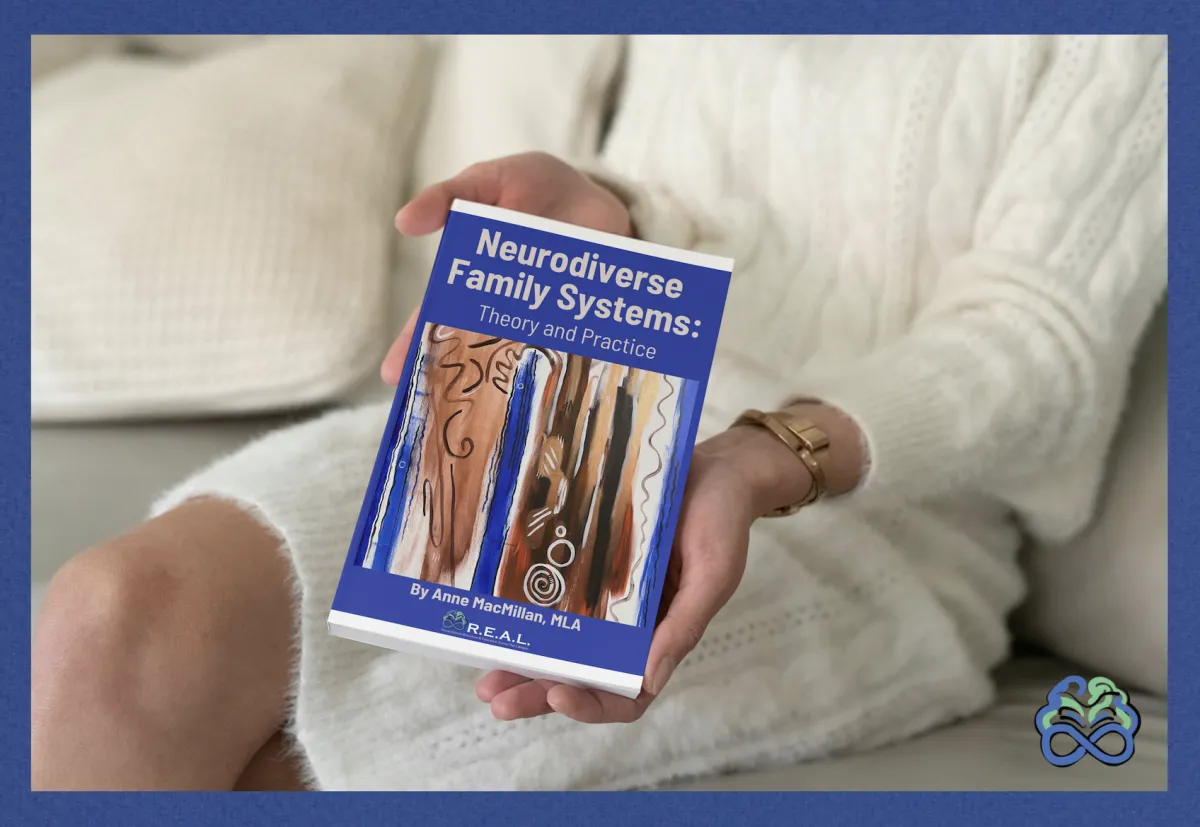
MacMillan's 10-Step Neurodiverse Family Systems Approach:
A Comprehensive Framework
to support neurodivergents and their families throughout adulthood.

Anne MacMillan, MLA
Founder of the 10-Step Neurodiverse Family Systems Approach, Speaker, Researcher, Consultant, Coach, Educator and Expert Witness
About Anne MacMillan
I built my original Neurodiverse Family Systems Theory on my education, personal life experience, and the professional experience I gained in the private neurodiverse services practice I founded in 2017.
Today, my services extend to support other professionals who have come to the new realization that neurodiversity is at the heart of many of the relationship challenges their adult clients face. Professionals can earn my Neurodiverse Family Systems Educator Credential (NFS-E) then use my practical 10-Step educational system, including quantitative assessments and support resources, to help their clients comprehend their relationship challenges and find the happiness and peace they deserve.
I have a research-based master's in psychology from Harvard University and studied developmental psychology as an undergrad. I received the Director's Thesis Award at Harvard for my original research on Level 1 autism and intimate life partnerships -- some of the first quantitative research on the subject in the world.
Altogether, I have over 50 years of personal life experience with neurodiverse family systems, over 20 years of personal life experience with neurodiverse intimate life partnerships, and 8 years of professional experience working with individuals managing the challenges of neurodiverse family systems.
I self-identify as a high body empathetic neurodivergent who just might also be a bit attention neurodivergent (ADHD). I am not autistic.
Our Services
Level 1 autism has a significant impact on dating, marriage, parenting, separation and divorce. Yet many individuals in neurodiverse intimate life partnerships (or life partnerships between autistics and non-autistics) had no idea that one partner was on the spectrum before tying the knot. Professionals, confused by the autism and Neurodiverse Relationship Dynamics (NRD), have offered misdiagnoses and poor advice, adding to the burden Level 1 autistics and their family members have faced.
Likewise, Level 1 autistic adults have little career support, facing the work world with little to no recognition that their autism affects their professional relationships.
R.E.A.L. Neurodiverse seeks to provide services that support these unmet needs.
MacMillan's Neurodiverse Family Systems Theory
Autistics and non-autistics perceive and navigate the social world differently. These differences create a phenomenon I term 'Neurodiverse Relationship Dynamics' (NRD).
Due to differences in neurological functioning, and at no fault of any family member, NRD contribute to perpetual cycles punctuated by emotional explosions called 'intermittent trauma spikes.'
Autistics and non-autistics also experience empathy differently, with autistics experiencing what emotion-sharing empathy' and non-autistics experiencing 'body empathy.' Empathy differences as well as different levels of 'empathic-emotion intensity' and 'emotion-origin awareness' can contribute to the trauma experienced during intermittent trauma spikes.
Both non-autistics and autistics can engage in harmful narcissistic behaviors within neurodiverse family systems. Increasing awareness of NRD can support all family members in reducing the level of narcissistic behaviors and in responding to them appropriately.
Neurodiverse families are commonly made up of three primary types of neurodivergents: autistics, attention neurodivergents (ADHD), and high body empathetics. And, of course, sometimes other neurodivergents and true neurotypicals crop up in neurodiverse famlies as well. All members of neurodiverse families need and deserve support regardless of neurology.
The tendency for individuals to select intimate life partners that are familiar to them alongside the fact that neurodiversity has a genetic component means that individuals from neurodiverse families commonly have children with other individuals from neurodiverse families, passing neurodiversity from generation to generation and creating the phenomenon of neurotribes.
Individuals in neurodiverse families commonly take upon themselves particular roles associated with both individual and systemic functions within their neurodiverse family systems. These roles are facilitated by the different neurologies and are more intractable than roles in neurotypical families. Gaining awareness of the roles and their functions can support individuals in neurodiverse family systems as they make sense of the relationship confusion they are experiencing and then make decisions and take actions to improve their lives.
Most professional services are designed with neurotypicals from neurotypical families in mind, abandoning neurodivergents from neurodiverse families to inadequate supports that tend to be irrelevant to their actual family experience and the relationship challenges they face in their daily lives.
I believe the first step to overcoming all this confusion is to have a foundational understanding of empathy differences, Neurodiverse Relationship Dynamics (NRD), and the manner in which trauma and multigenerational behavioral patterns (facilitated by neurodiversity) affect neurodivergents within neurodiverse family systems.
My original Neurodiverse Family Systems Theory and my 10-Step Neurodiverse Family Systems Approach seek to fill this gap and to provide professionals and members of neurodiverse families the information they need so all individuals from neurodiverse families can find the happiness and peace they deserve.

Anne MacMillan, MLA
Founder of the R.E.A.L. 10-Step Neurodiverse Family Systems Approach, Speaker, Researcher, Consultant, Coach, Educator and Expert Witness

MacMillan's 10-Step
Neurodiverse Family Systems Approach

What is a Neurodiverse Adult Relationship?
Often neither partner knew about the autism when the relationship began.
What is neurodiverse marriage?
A neurodiverse intimate adult relationship is a relationship between a person with high-functioning autism and a typically developing, or “neurotypical,” person. Neurotypical people are people who don’t have autism or another developmental disorder. In a nutshell, high-functioning autism is autism (or ASD) without cognitive or language impairment.
Many people with high-functioning autism will marry and have successful careers.
Chances are that some of the high-level employees in your workplace have high-functioning autism. They can be doctors, surgeons, data analysts, financial analysts, IT professionals, programmers, physicists… you name it. Those who are able to find employment within their niche interests are often able to contribute unique skills to the workforce. And not all people with high-functioning autism in the workforce are in exceptionally high-level jobs. In most cases, their colleagues will not be aware that they have ASD. Your colleague in the next cubical could have ASD and you wouldn’t necessarily know it.
Autism has a genetic component and sometimes people with high-functioning autism aren’t themselves aware that they might be on the spectrum until a family member, usually a child, is diagnosed. In some families, one parent and one or more children have ASD.
High-functioning autism is easier to recognize in children than adults and until the last twenty years or so, most children with high-functioning autism went without the advantage of a diagnosis. These children used their intellect and their resourcefulness to develop compensatory strategies on their own. By the time they reached adulthood, those strategies masked the most obvious signs of ASD.
Often, neither they nor their current intimate partners knew about the autism when their intimate relationships began.
Intimate adult relationships between typically developing adults and adults on the autism spectrum are mixed relationships because the partners are neurologically dissimilar in a manner that affects their communication and social interactions. Intimate adult relationships are commonly accepted as the most important relationships of one’s lifetime and successful communication and social enjoyment are critical to adults’ satisfaction within them.
Currently partners in neurodiverse relationships have few resources to help them navigate their differing communication styles. There is more acknowledgment that neurodiverse relationships exist now than there was just a few years ago, but the professional world is still scrambling to figure out how to support individuals managing them.
Most of us have heard of mixed-orientation relationships and mixed-faith relationships and the difficulties that arise between partners who navigate these differences. It is less common to consider the friction that may occur when the incompatibility between partners is neurological.
My programs provide information, strategies, resources and support for typically developing members of mixed-neurological relationships and their partners.

Pre-Order Your
Copy Today
Neurodiverse Family Systems: Theory and Practice
By Anne MacMillan, MLA
© 2024 R.E.A.L. Neurodiverse
All Rights Reserved
anne@REALneurodiverse.com
Text or Call: (617) 996-7239 (United States)
